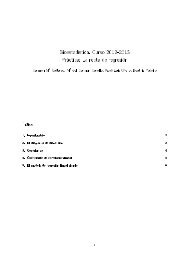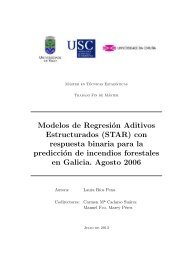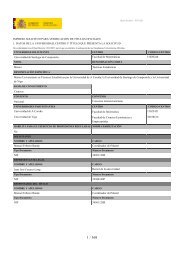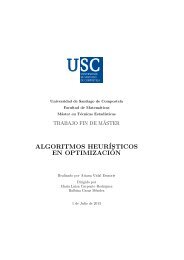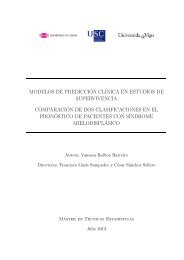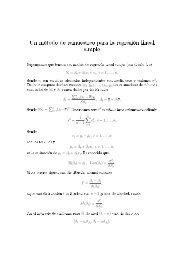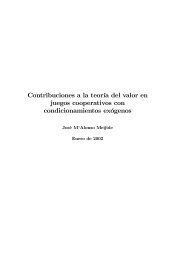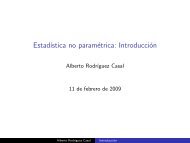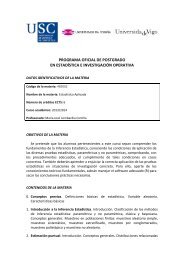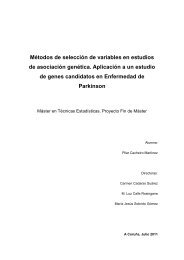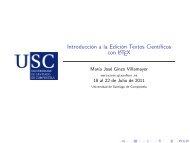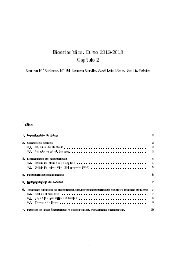Bootstrap independence test for functional linear models
Bootstrap independence test for functional linear models
Bootstrap independence test for functional linear models
Create successful ePaper yourself
Turn your PDF publications into a flip-book with our unique Google optimized e-Paper software.
Remark 2. Note that another usual assumption is that the intercept term vanishes. Although thisis not common in most of situations, it should be noted that if b = 0 and X is not assumed to becentered (as in this work), then an interesting possibility appears: to check whether Θ 1 = 0 or notby checking the nullity of the intercept term of the model, and thus to check the original hypothesis<strong>test</strong>ing in (2). This open problem cannot be solved with the methodology employed in the currentpaper (or in the previous ones) because the idea is based on checking (6), which is equivalent to therestricted <strong>test</strong> (5) but not to the unrestricted one in (2).2.3 Testing procedure and asymptotic theoryAccording to the relation between ‖ · ‖ ′ and ‖ · ‖, the dual norm of ∆ ∈ H ′ can be expressedequivalently in terms of the H–valued random element (X − µ X )(Y − µ Y ) as follows‖∆‖ ′ = ‖〈E ((X − µ X )(Y − µ Y )) , ·〉‖ ′ = ‖E ((X − µ X )(Y − µ Y )) ‖.Thus, based on an i.i.d. sample {(X i , Y i )} n i=1drawn from (X, Y ),D = ‖E ((X − µ X )(Y − µ Y )) ‖ = ‖T ‖can be estimated in a natural way by means of its empirical counterpart D n = ‖T n ‖, where T n isthe H–valued random element given byT n = 1 nn∑(X i − X)(Y i − Y ),i=1where X and Y denote as usual the corresponding sample means. The next theorem establishessome basic properties of T n .Theorem 1. Assuming that (1) holds with E(ε) = 0, E(ε 2 ) = σ 2 < ∞ and E(‖X‖ 4 ) < ∞, then1. E(T n ) = E ((X − µ X )(Y − µ Y )) (n − 1)/n2. T n converges a.s.–P to E ((X − µ X )(Y − µ Y )) as n → ∞3. √ n (T n − E ((X − µ X )(Y − µ Y ))) converges in law, as n → ∞, to a centered Gaussian elementZ in H with covariance operatorΓ Z (·) = σ 2 Γ(·) + E ( (X − µ X )〈X − µ X , ·〉〈X − µ X , Θ〉 2) .Proof. Since T n can be equivalently expressed asT n = 1 nn∑(X i − µ X )(Y i − µ Y ) + (X − µ X )(Y − µ Y ),i=1it is straight<strong>for</strong>ward to check item 1. The a.s.–P convergence is a direct application of the SLLN<strong>for</strong> separable Hilbert–valued random elements.On the other hand, given that E(‖(X − µ X )(Y − µ Y )‖ 2 ) < ∞, the convergence in law can bededuced by applying the CLT <strong>for</strong> separable Hilbert–valued random elements (see, <strong>for</strong> instance, Lahaand Rohatgi (1979)) together with Slutsky’s Theorem. The concrete expression of the operatorΓ Z , that is, Γ Z = Γ (X−µX )(Y −µ Y ) = Γ (X−µX )ε + Γ (X−µX )〈X−µ X ,Θ〉, can be obtained by simplecomputations.In order to simplify the notation, from now on, given any H–valued random element H withE(‖H‖ 2 ) < ∞, Z H will denote a centered Gaussian element in H with covariance operator Γ H .5



